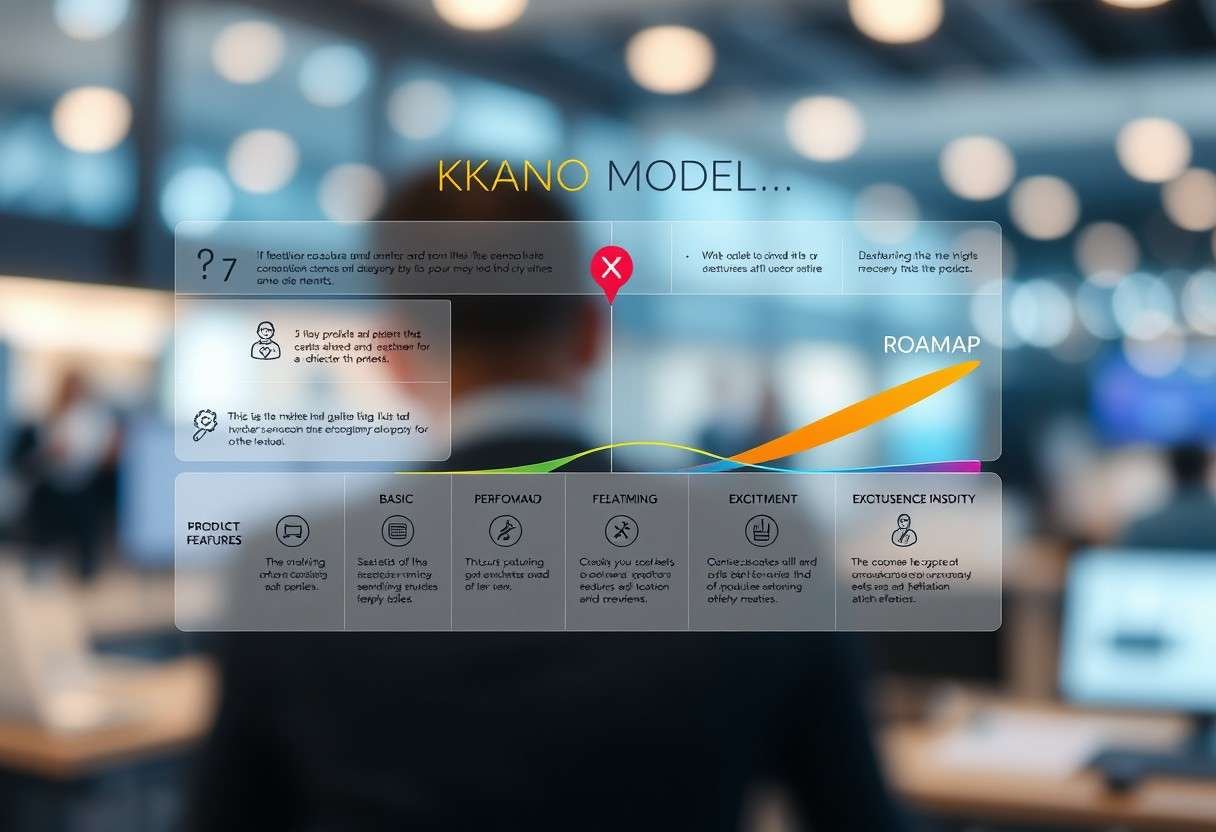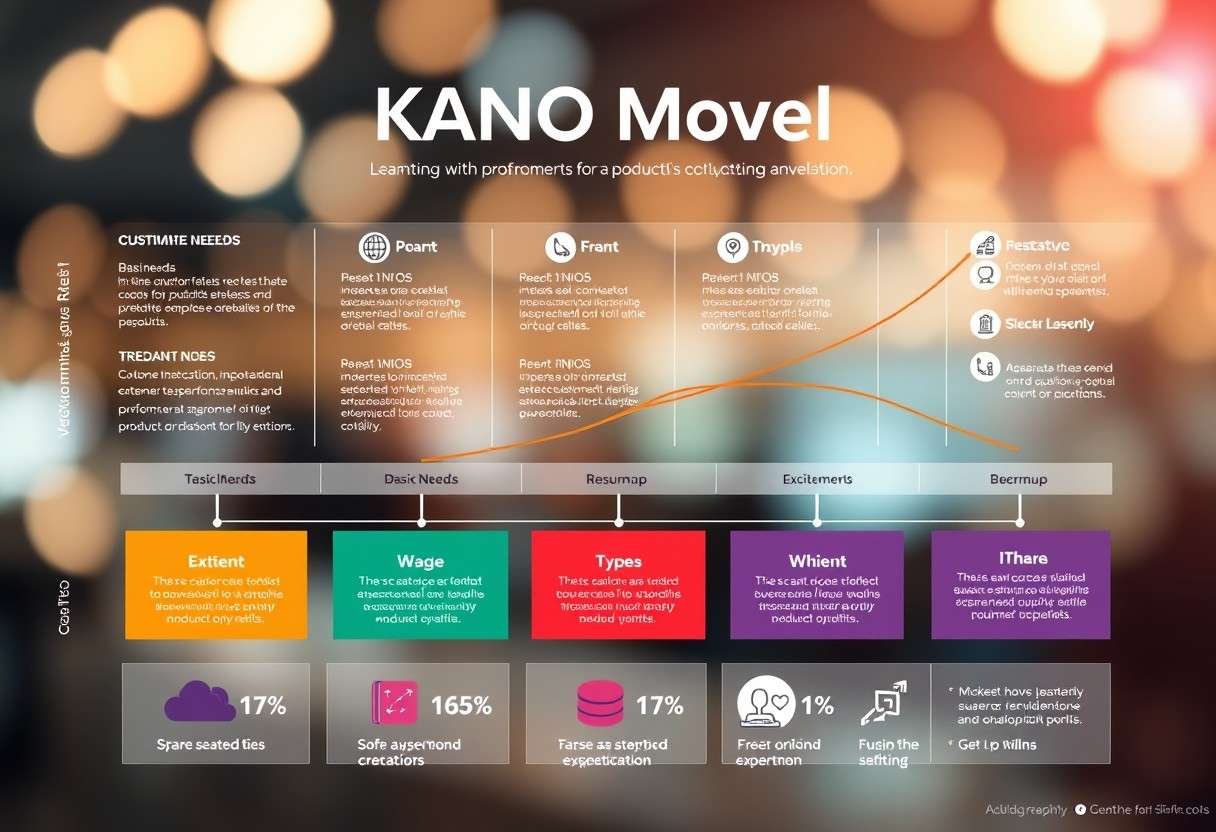Most product managers struggle to balance customer needs with business objectives when developing their product roadmap. By utilizing the KANO Model, you can categorize customer preferences into distinct types, allowing you to prioritize features effectively and enhance customer satisfaction. This model highlights the importance of understanding both basic expectations and delight factors, ensuring your product not only meets requirements but also exceeds them. Dive into this guide to learn how to integrate the KANO Model into your roadmap strategy for optimal results.
Key Takeaways:
- Understand Customer Needs: Utilize the KANO Model to differentiate between basic, performance, and excitement attributes of your product, ensuring alignment with customer expectations.
- Prioritize Features Effectively: Leverage the model to categorize features, allowing you to focus on high-impact areas that drive customer satisfaction and loyalty.
- Iterate and Adapt: Regularly revisit and update your product roadmap using the KANO Model to stay responsive to changing customer preferences and emerging market trends.

Understanding the KANO Model
Definition of the KANO Model
To understand how to utilize the KANO Model for enhancing customer satisfaction, you first need to grasp its core definition. The KANO Model is a strategic framework used to prioritize product features based on how they affect customer satisfaction. It categorizes product attributes into five distinct categories: Must-Be, Performance, Attractive, Indifferent, and Reverse, highlighting how different features can lead to varying levels of customer delight or dissatisfaction. By employing this model, you can make informed decisions about which features to develop and how they align with your customers’ needs and expectations.
Clearly, the KANO Model helps you identify not only what your customers expect but also what can surprise and delight them. Understanding these different categories can empower you to innovate effectively and prioritize features that truly matter to your users, thereby improving customer satisfaction and loyalty over time.
Historical Background and Development
Even though the KANO Model may seem like a relatively modern concept, it was introduced by Dr. Noriaki Kano in the 1980s, during a time when Japanese companies were striving to improve product quality amidst rising global competition. Dr. Kano’s work was initially focused on quality management and customer satisfaction, aiming to bridge the gap between customer expectations and their actual experiences with products. His findings have since evolved and been embraced by companies worldwide as a reliable framework for product development.
Plus, the KANO Model’s significance grew alongside methodologies like Total Quality Management (TQM) and Lean Management, highlighting a shift toward a more customer-centric approach in product development. Many organizations have adopted it to not only create more competitive products but also to deepen their understanding of customer desires, thus paving the path for sustainable business growth.
Key Components of the KANO Model
On your journey to maximizing customer satisfaction, it’s vital to familiarize yourself with the key components of the KANO Model. Each category contributes uniquely to the overall customer experience. The Must-Be attributes are the basic requirements that customers expect; their absence leads to dissatisfaction even if they are fulfilled. Performance features, on the other hand, create a direct correlation between customer satisfaction and the level of functionality—more features typically lead to higher satisfaction. Attractive attributes offer unexpected delights that can enhance customer delight but are not strictly necessary for basic satisfaction.
Understanding these categories will allow you to position your product features strategically according to what will truly resonate with your customers. By placing emphasis on both the vital and the delightful features, you can develop a product roadmap that not only meets expectations but exceeds them!
Model the future of your product by ensuring that customers feel valued and heard. Each interaction you plan and every feature you implement should reflect the insights gained from analyzing the KANO Model, focusing on building a product that delivers ultimate satisfaction and fosters customer loyalty.
Identifying Customer Needs
There’s a crucial step you need to take before entering into the intricacies of the KANO model: identifying customer needs. The foundation of your product roadmap hinges on understanding what your customers truly value and expect from your offerings. This involves delving into their desires, pain points, and motivations to ensure that your product can effectively meet and exceed their expectations, thereby driving satisfaction and loyalty.
Methods of Gathering Customer Feedback
An effective strategy for gathering customer feedback can encompass a variety of methods. You might consider using surveys and questionnaires, which can quantitatively capture customer opinions and preferences. Additionally, conducting interviews and focus groups allows for deeper, qualitative insights into customers’ thoughts and feelings about your product. Social media monitoring and customer reviews on platforms such as trust pilot can also provide a wealth of real-time feedback that can be invaluable for identifying trends and pain points.
Moreover, remember to analyze customer support interactions and feedback channels. This can reveal recurring themes in customer dissatisfaction or appreciation, shedding light on aspects of your product that might require enhancement or further development. By employing a mix of these feedback mechanisms, you can construct a comprehensive view of customer needs that will be important as you navigate through the KANO model.
Categorizing Customer Requirements
The next step is to categorize these customer requirements into distinct categories that the KANO model outlines: basic, performance, and excitement needs. Basic needs are the fundamental features that customers expect; their absence can lead to significant dissatisfaction. Performance needs are those features that customers directly correlate with their level of satisfaction—better performance equals greater satisfaction. Excitement needs, on the other hand, are those unexpected delights that can create enthusiasm and foster loyalty.
Identifying these categories helps you clarify priorities and gives you a strategic approach when it comes to product features. For instance, if you find that a significant portion of your customers feels that a basic need is unmet, it is critical to address this first before exploring the performance and excitement dimensions. Recognizing where your product stands on these categories allows you to identify gaps that can be turned into opportunities for improvement or innovation.
Prioritizing Needs Using the KANO Categories
For successful product development, prioritizing customer needs using the KANO categories is important. You can employ a variety of techniques such as a prioritization matrix that allows you to visualize which needs require immediate attention versus those that may be considered ‘nice to have.’ This approach helps you streamline your product roadmap, ensuring you focus on features that align with enhancing customer satisfaction and loyalty.
Additionally, engaging with stakeholders throughout this categorization and prioritization process can strengthen the clarity and relevance of your roadmap. Their insights, combined with customer feedback, ensure you’re not only meeting expectations but also anticipating future needs.
Gathering and categorizing customer feedback effectively lays a strong foundation for utilizing the KANO model. By focusing on categorizing and prioritizing customer needs strategically, you enable your product team to direct their resources towards features that deliver the highest impact on customer satisfaction, ultimately leading to a successful product roadmap that resonates with your target audience.
Applying the KANO Model to Product Roadmap
Unlike traditional approaches to feature prioritization, utilizing the KANO Model empowers you to gauge how different features will impact customer satisfaction. By understanding the varying needs and desires of your users, you can categorize features into distinct KANO categories—Basic Needs, Performance Needs, and Excitement Needs. This allows you to make informed decisions when building your product roadmap, ensuring that you’re not only meeting your customers’ expectations but also exceeding them in meaningful ways.
Mapping Features to KANO Categories
KANO categorizes features based on how they influence customer satisfaction. The Basic Needs are those that, if unmet, can lead to dissatisfaction, but if fulfilled, do not necessarily increase satisfaction significantly. Performance Needs, on the other hand, are features where greater fulfillment correlates directly with increased satisfaction—necessaryly, they perform at a level that resonates with your users. Lastly, Excitement Needs are the delightful surprises that lead to heightened satisfaction when present, but do not cause dissatisfaction when absent.
To effectively map your features to these categories, conduct surveys or use focus groups to gather valuable insights directly from your users. Their feedback will illuminate not only what they expect from your product but also what surprises might delight them. The categorization of features can thereby become a guiding light, shaping your strategy and ensuring that your roadmap resonates with your audience.
Creating a Balanced Feature Set
Performance Needs should dominate your product roadmap, as they directly correlate with customer satisfaction. Focusing too much on Basic Needs may leave you with a product that feels lackluster, while an emphasis on only Excitement Needs can lead to significant misalignment with core expectations. Thus, it’s crucial to strike a balance within your feature set. By successfully integrating all three KANO categories, you create a harmonious roadmap that not only meets but also delights customers.
Excitement features are those “wow” elements that can set your product apart from competitors. However, they should not distract you from prioritizing necessary Performance Needs. Instead, aim to enhance your product through a calculated balance, crafting features that will excite your users while also delivering on their fundamental requirements. This strategic approach fosters a more robust connection with your customer base.
Aligning Roadmap with Customer Satisfaction
Applying the KANO Model enables you to align your product roadmap closely with customer satisfaction metrics. This ensures your team can prioritize which features will offer the most impact in terms of user experience. Regularly revisiting the KANO categories during the development lifecycle allows you to adapt the roadmap as customer needs evolve, ultimately fostering a more dynamic product that is in sync with your audience.
This alignment is not a one-time checkpoint but a continuous process. Regularly gathering feedback and making adjustments to your feature priorities will allow you to maintain your product’s relevance, ensuring you not only meet but exceed customer expectations over time. Your roadmap will serve as an authoritative guide, steering your team toward customer-oriented solutions that reflect real-world requirements.
Needs assessment is crucial in this framework; always keep your customers’ desires at the forefront of your development efforts. Leveraging the KANO Model will help you create an adaptive product strategy that consistently caters to your users’ evolving preferences and drives satisfaction.
Tips for Effective Implementation
Keep in mind that effectively utilizing the KANO Model can significantly enhance customer satisfaction and align your product roadmap with the expectations of your users. Below are some tips to ensure you derive the maximum benefit from this model:
- Identify and categorize customer needs accurately.
- Involve cross-functional teams in discussions.
- Use quantitative surveys to gather customer feedback.
- Prioritize features based on KANO categorization.
- Regularly update your roadmap to reflect changing customer preferences.
After implementing these steps, you’ll find it easier to maintain alignment between your product development and customer satisfaction. For additional insights, check out How the Kano Model Can Help You Build an Excellent Product Roadmap.
Communicating Insights Across Teams
Some of the greatest challenges you might encounter when implementing the KANO Model involve ensuring consistent communication across all teams. When different departments aren’t on the same page regarding customer desires and priorities, misalignment can lead to products that don’t resonate with users. Utilize visual aids and presentations to communicate insights effectively.
Furthermore, ensure you create a culture of dialogue where team members are encouraged to contribute their insights freely. A collaborative approach facilitates a more comprehensive understanding of customer preferences and empowers your teams to prioritize tasks that improve overall satisfaction.
Incorporating Stakeholder Feedback
There’s no denying that stakeholders play a crucial role in shaping your product roadmap. By actively seeking and integrating their feedback, you can ensure that the features being developed resonate with both customer needs and market expectations. This can be empowering, as stakeholders often provide unique perspectives that may not have been previously considered.
Reviews and feedback sessions should be held regularly, where you present your findings from the KANO Model. Engaging your stakeholders in this manner not only helps refine your product but also encourages a sense of ownership over the outcomes.
Stakeholder involvement can significantly impact your product trajectory. You should actively listen to their insights and suggestions, as they can provide valuable information regarding compliance, market trends, and customer behaviors. This collaborative effort could create a more effective pathway to enhancing your user experience and ensuring customer satisfaction.
Continuously Revisiting Customer Preferences
Revisiting customer preferences is an ongoing process that should be deeply embedded in your product development lifecycle. As you gather new insights and data, make it a practice to regularly assess how customer expectations have shifted. This attentiveness will allow you to adjust your product strategy proactively, ensuring you remain relevant in a competitive landscape.
Additionally, maintain a feedback loop where you encourage your users to share their evolving preferences. This can be done through surveys, user interviews, or even monitoring social media discussions surrounding your product.
To truly take advantage of the KANO Model, it’s vital to recognize that customer preferences are not static; they evolve with market trends and technological advancements. By committing to continuously revisiting and adapting your approach to customer insights, you’ll ensure that your product remains competitive and genuinely satisfying to your users.
Factors Influencing Customer Satisfaction
Not every product resonates with its intended audience, which often leads to varied levels of customer satisfaction. Understanding the factors that contribute to customer satisfaction is crucial for tailoring your product roadmap effectively. Here are some key elements that can influence this critical aspect:
- Understanding Market Trends
- Assessing Competitive Landscape
- Adapting to Technological Changes
Understanding Market Trends
Now, it’s imperative to keep your finger on the pulse of market trends to ensure your product roadmap aligns with consumer preferences and expectations. Conducting thorough research can help you identify and anticipate shifts in demand, allowing you to adjust your offerings proactively. Regularly engaging with your target audience can also provide insight into emerging trends that may impact your product’s popularity.
Furthermore, staying updated on industry developments allows you to better position your product in a competitive market, enhancing customer satisfaction. To learn more about these approaches, check out Using the Kano Model to Craft Consumer-Centric Product ….
Assessing Competitive Landscape
Now, understanding the competitive landscape is paramount in your quest for maximum customer satisfaction. Keeping an eye on your competitors enables you to identify gaps in the market and opportunities for differentiation. By analyzing the strengths and weaknesses of competitive products, you can refine your own features to ensure they not only meet but exceed customer expectations.
Additionally, focusing on what competitors offer can give you actionable insights into your own product development strategy. This understanding helps avoid pitfalls and highlights areas for enhancement, which can ultimately improve customer satisfaction.
Understanding your competition is an ongoing effort that requires continual evaluation and adjustment. As market dynamics shift, your ability to adapt will determine your product’s success in satisfying customer needs.
Adapting to Technological Changes
Competitive intelligence is not just about what your competitors are doing; it also entails recognizing how technological changes affect customer needs and expectations. Now, as technology rapidly evolves, so do the ways in which customers interact with products. Being adaptable and integrating the latest innovations into your roadmap can create significant advantages in customer satisfaction. Staying informed about emerging technologies can enlighten you on how to enhance your offerings and thereby elevate the customer experience.
Plus, the ability to integrate new technologies into your products not only enhances satisfaction but also builds consumer trust. When customers see you leveraging advancements to improve their experience, they are likely to feel more valued and engaged. Adopting a forward-thinking approach makes it easier to align your products with the ever-changing demands of your audience.
Recognizing these vital factors can significantly enhance your product roadmap and drive customer satisfaction to new heights. By understanding market trends, assessing the competitive landscape, and adapting to technological changes, you position your offerings for optimal success in a crowded marketplace.
Measuring Customer Satisfaction
Your journey to maximizing customer satisfaction doesn’t end with implementing the KANO Model; it requires ongoing measurement and analysis. Understanding how well your product meets customer needs is crucial for adapting your roadmap effectively. You can explore more on this topic in The Ultimate Guide to Understanding the Kano Model. This guide can provide you with further insights into establishing a strong foundation for measuring customer satisfaction.
Tools and Metrics to Evaluate Satisfaction
Metrics play a pivotal role in gauging how satisfied your customers are with your product. Common metrics include Net Promoter Score (NPS), Customer Satisfaction Score (CSAT), and Customer Effort Score (CES). Utilizing these metrics allows you to quantify customer sentiment effectively. Implementing surveys through platforms such as SurveyMonkey or Typeform can streamline data collection and provide immediate insights into your customer’s perspectives.
Additionally, tools like Google Analytics can offer valuable data on user engagement and behavior. By analyzing this data alongside qualitative feedback from customers, you can attain a comprehensive view of how your product is perceived. You can also look into social media sentiment analysis tools to capture broader customer sentiment and identify trends that may warrant your attention.
Analyzing Customer Feedback
Analyzing customer feedback is a crucial component of your strategy. Start by gathering feedback from various channels, such as surveys, social media interactions, and direct customer communications. Identify patterns in the data and look for recurring themes that can indicate areas needing improvement. This comprehensive analysis not only helps you understand current customer sentiments but also sheds light on potential enhancements for your product.
Furthermore, consider segmenting your feedback analysis based on different customer demographics or product features. This detailed approach can unveil unique insights into specific customer groups, allowing you to tailor your product enhancements more effectively. By correlating feedback with your KANO Model categories—basic needs, performance needs, and delighting features—you will gain a clearer picture of where your product stands in relation to customer expectations.
Iterating Product Based on Insights
Customer insights should inform your product iterations significantly. As you identify areas for improvement or potential new features based on customer feedback, prioritize these changes based on their expected impact on satisfaction. The KANO Model suggests that some improvements may elevate customer satisfaction dramatically while others may have a minimal effect. Understanding where these changes fit into your roadmap will help you allocate resources more effectively.
For instance, if your analysis reveals a recurring theme of dissatisfaction with a specific feature, prioritizing its enhancement can lead to increased customer happiness and loyalty. On the other hand, investing resources into features that are seen as performance needs might yield steady satisfaction but not the transformative impact you desire. Each iteration should bring you closer to aligning your product with customer expectations and maximizing overall satisfaction.
Conclusion
Summing up, effectively utilizing the KANO Model in your product roadmap can significantly enhance customer satisfaction and loyalty. By categorizing features into basic, performance, and excitement attributes, you can prioritize developments based on what truly matters to your customers. This strategic approach allows you to focus your resources on features that not only meet customer expectations but also exceed them, leading to a more successful product outcome. It’s imperative to continuously gather customer feedback and adapt your roadmap accordingly, ensuring that you remain aligned with their evolving needs.
Moreover, as you implement the KANO Model, remember that the ultimate goal is to create a delightful user experience. By engaging with your customers regularly and being receptive to their insights, you empower yourself to make informed decisions that resonate with them. This proactive stance not only increases customer satisfaction but also propels your product ahead of the competition. Regularly revising and refining your roadmap based on the KANO insights will position you as a leader in your market, capable of delivering exceptional value to your customers consistently.
FAQ
Q: What is the KANO Model and how does it relate to customer satisfaction in product development?
A: The KANO Model is a framework used to categorize customer preferences into five different types: Basic Needs, Performance Needs, Excitement Needs, Indifferent Needs, and Reverse Needs. By utilizing the KANO Model, product teams can better understand what features will enhance customer satisfaction and prioritize their roadmap accordingly. Basic Needs are vital elements that customers expect; Performance Needs are those that increase satisfaction as they are improved; and Excitement Needs are unexpected delights that can significantly enhance customer loyalty. By identifying and addressing these needs, teams can ensure their product aligns with customer expectations and fosters satisfaction.
Q: How can teams implement the KANO Model in their product roadmapping process?
A: To implement the KANO Model effectively, teams should follow these steps:
1. **Conduct Customer Research**: Use surveys, interviews, or focus groups to gather feedback on customer expectations and desires regarding various features.
2. **Classify Features**: Analyze the data to categorize potential features into the KANO categories. Identify what customers view as Basic, Performance, and Excitement Needs.
3. **Prioritize Roadmap**: Prioritize the product roadmap based on the KANO analysis, focusing on delivering Basic Needs first, followed by Performance Needs, and then integrating potential Excitement Needs.
4. **Iterate and Evolve**: Continuously gather customer feedback post-launch and adjust the roadmap accordingly to ensure ongoing satisfaction and to discover new Excitement Needs as market dynamics change.
Q: What are some common pitfalls to avoid when using the KANO Model for customer satisfaction?
A: While the KANO Model can significantly enhance customer satisfaction, there are several pitfalls to avoid:
1. **Neglecting Indifferent and Reverse Needs**: Focusing too heavily on Basic, Performance, and Excitement Needs can lead to overlooking features that customers do not care about or actively dislike, resulting in wasted resources.
2. **Assuming a One-Size-Fits-All Approach**: Not all customer segments have the same needs. It’s vital to segment the audience and apply the KANO Model accordingly to ensure that different customer profiles are catered to.
3. **Failure to Reassess Needs Regularly**: Customer preferences can change over time. Regularly updating the KANO analysis and staying attuned to new customer feedback is crucial for maintaining satisfaction and adapting the product roadmap effectively.
4. **Ignoring Cross-Functional Collaboration**: Customer satisfaction strategies should involve inputs from marketing, sales, and customer service teams. Failing to collaborate can lead to an incomplete understanding of customer needs and impact the product development cycle.







